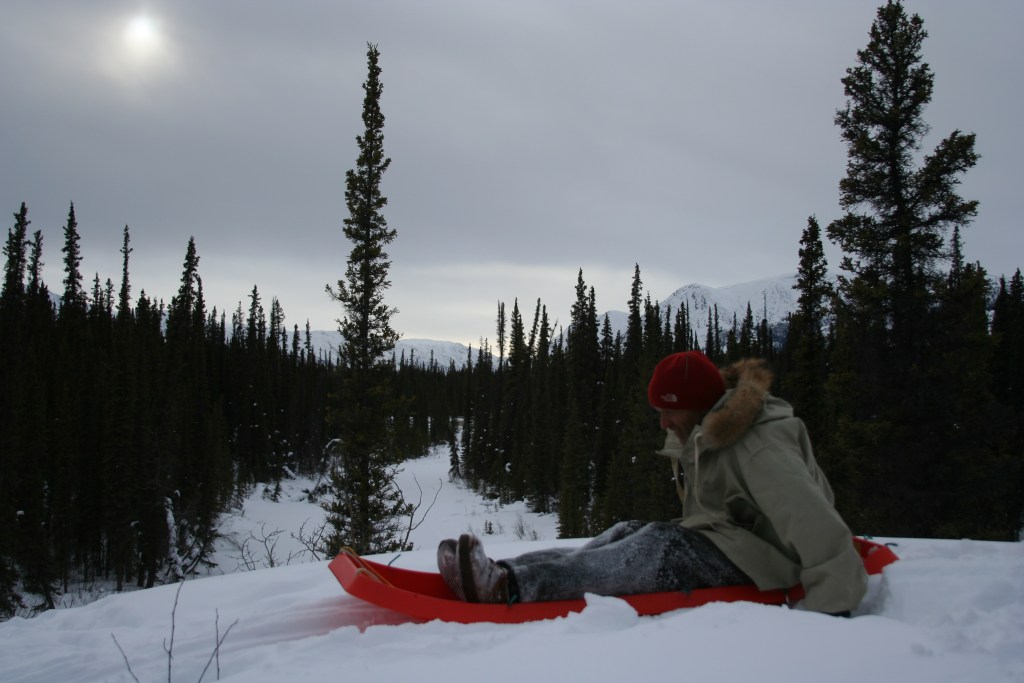A Fine Day of Sledding

We had just been graced with another inch or so of snow and I wondered if this November covering would pronounce the birth of a winter landscape or would we teeter-totter into another unseasonable warm stretch. So while there was snow it was time to fetch one of our sleds.
Opening the garage door, I wove my way around the car and stored canoes. Suspended above me is the homemade birch toboggan that hangs from the rafters as a sort of winter gear shelf. Beside a stack of cross-country skis and poles is a pair of six-foot plastic sleds.
To minimize a clattering avalanche of winter fun, I carefully extracted one of the red sleds. Both are veterans of work and fun and each have collected their own stories.
I suspect that the earliest use of sleds by humans was to more easily move things. Early humans were nomadic so it makes perfect sense that a sled of some form, likely a large animal hide, could ease the task. And during those sledding passages, they learned the agony of pulling uphill and the relief of a downhill glide.
Ecstasy was an added reward once people realized that sleds, combined with the magic of gravity and a steep hill, could be used for simply carrying the cargo of passengers only.
My annual reunion with sleds evokes memories. In years past, and hopefully in future winters, Miss Nancy’s and my sleds have resembled Conestoga wagons when they were loaded with winter camping and fishing gear to head into the Boundary Water Canoe Area Wilderness for a week of solitude.
I have used a sled in imaginary international luge competitions held above the Watson River in the Yukon Territory. (See blog entry for 2009)

And then there was the day I tried using the sled as a surfboard where for a brief moment, okay “brief” is being generous. I caught a frozen downhill wave and ended up trashing in a wipeout.
But on this day, I would be using the plastic sleigh to stage firewood from our north woodshed to the door stoop where we could more easily carry armloads into the porch woodbox. The sled is used to carrying chunks of oak and black cherry.
Every winter Miss Nancy and I pull cords of firewood from our woodlot to the woodsheds. While I cut and split the downed trees, Miss Nancy plays draft horse and repeatedly pulls the sled and its cargo out of the woods. She loves it for the workout it gives her.
We were once offered a great deal on an almost new ATV to help with Basecamp chores such as gathering firewood and snow removal. We deliberated the acquisition for long seconds before turning it down. We both felt the machine would be more of an anchor and hassle than a red plastic sled. Storage, gasoline, oil and associated noise, smells and costs would have to be dealt with. And more importantly, our homestead workout would mostly disappear. Why complicate life when it can be simpler and healthier?
After I messed around giving firewood sled rides, I leaned the craft up against the shed. I’ve learned long ago that it is a good idea to store a sled on its vertical axis with the bottom facing the low hanging south sun. Even the slightest bit of snow or ice can impede the smooth glide of the sled and make pulling a task rather than fun.
With firewood sledding done, the sun read mid-afternoon. I walked into the woods, climbed into a deer stand with my trusty recurve bow and arrows to hunt deer for the last couple hours of the day.
As fate would have it, before sunset I needed my sled again. I had a heavy whitetail buck to pull home. I felt like a red-cheeked boy returning to the warmth of home after a grand day of sledding.

Filed under: Uncategorized

Leave a Reply
You must be logged in to post a comment.